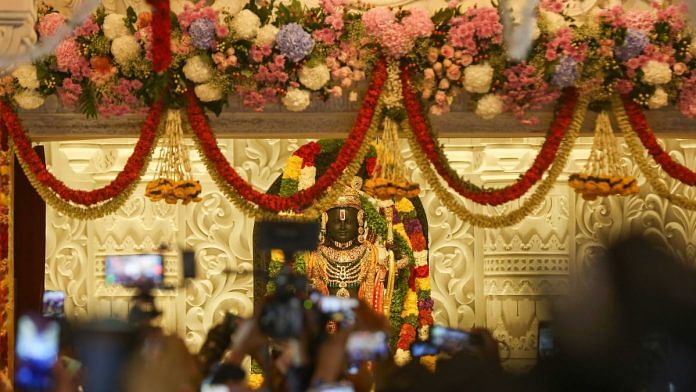The Ram Mandir and the long struggle that culminated in Pran Pratishtha on 22 January 2024 are unique in many ways. The national and global euphoria and jubilation that followed the ceremony in Ayodhya can only be compared to something experienced immediately after Independence in 1947. As reflected in the Cabinet resolution, the nation gained political independence in 1947, and probably the soul of the nation, the Chiti, as Deendayal Upadhyaya explained in his Integral Humanism, was freed of a blot after the Ram idol was reinstalled after about five centuries. The moment was filled with a sense of achievement and fulfilment rarely experienced in the last seven or so decades.
The Ram Mandir is not merely a brick and mortar structure; it is the resurrection of Hindu pride that was hurt centuries ago by a marauding horde of plunderers. The plundering was not for wealth alone and it wasn’t a treasure hunt. The objective of vandalising the “janmasthan temple” was part of the religious command to destroy the idols of the unbelievers, butparast, (idol worshippers). Mahmud of Ghazni, a butshikan (idol destroyer), took pride in owning responsibility for the destruction of the Somnath temple.
Rebuilding the Somnath temple soon after Independence and the tragic Partition, a time when Hindu-Muslim relations were extremely strained, did not result in riots or vitiate the communal atmosphere. There was no fear of ‘Hindu majoritarianism’ trampling minorities under its sway; no foreign journal reported that ‘a temple is built over a mosque.’ But Ram Mandir at Ayodhya is reported as “a giant temple opened by Modi in a triumph for India’s Hindu nationalists.” The New York Times describes with impunity that the “temple inaugurated by the prime minister is on the disputed site of a centuries-old mosque destroyed in a Hindu mob attack that set a precedent of impunity in cases of violence against Muslims.” The learned editors of the newspaper need to do more homework, read through the Supreme Court judgment, and understand India better if they want to be considered true to their profession. If they want to excel in yellow journalism, it is their prerogative.
Also read: After Ayodhya, Indian secularism must stay vigilant, not give in to religious obscurantism
A new life
Like rebuilding the Somnath temple, the Ram Mandir too has infused new life into the body politic of the nation. What is particularly noteworthy is that the Ayodhya issue was resolved through a court order in a Hindu majority country by pleading a case for several years, even though an insensitive UPA government went to the extent of denying the very existence of Ram. History is witness to the fact that the Ayodhya case had to experience several ups and downs, conflicts, deceits, and setbacks, in spite of the Hindus being the victims of the vandalisation of their Ishta Devta’s temple. The Congress government, when in power, went to the extent of informing the Supreme Court that Ram never existed and that Maharishi Valmiki’s Ramayana lacks scientific and historical veracity. And now the same party is torn between two options of boycotting the event and sending an appropriate message to the antagonists of the Ram temple and claiming the first mover advantage to be on the right side of the majority. It is doomed to fall between two stools. Its stand on the other two important places of worship, Kashi and Mathura, will be interesting to watch.
The courts are seized of the matters pertaining to the illegal mosques adjoining Sri Krishna Janmasthan temple in Mathura and Kashi Vishwanath temple in Varanasi. Considering the quantum of historical and archaeological evidences available in both places of worship and reverence, it would not be surprising if the courts decide in favour of the Hindus’ claims. However, one hopes that unlike in the case of Ayodhya, here, the courts need not offer the contesting parties another site to build a mosque as a sop to placate them for the “generosity” of accepting the court verdict. The present Islamic structures are neither legal nor architectural marvels that they need to be preserved and shifted to an alternative place. They appear as grotesque structures hurriedly erected over Hindu temples as a slap on the face of woefully disunited Hindus lacking strength, political or otherwise. It would be a travesty of justice if Hindus have to accept an ‘Ayodhya-like solution’.
The political class and the intellectuals still living in a denial mode will take some time to adjust to the reality of the Ram Mandir. Mathura and Kashi will add to their dismay and misplaced consternation as they continue to peddle conspiracy theories and play majority versus minority games. The Muslim society is also undergoing a metamorphosis, barring a few who prefer to play into the hands of political moneybags for pecuniary reasons.
As for the government, it is time to turn its attention to other pressing matters domestically and in the international arena. The flashpoints in the Middle East are threatening to move closer home and knock at our door in the Western sector. We urgently need to reach out to our neighbours, strengthen confidence-building measures, and improve trade and other relations. Domestically, there is a need to maintain harmony and composure, a message that was underlined by both Prime Minister Narendra Modi and RSS Sarsanghchalak Mohan Bhagwat in their 22 January speeches in Ayodhya.
Seshadri Chari is the former editor of ‘Organiser’. He tweets @seshadrichari. Views are personal.
(Edited by Prashant)




Let’s not waste time bothering over Western media reactions. They are not worth the paper they are written on.
This is the first article I’ve read from a prominent media agency that captures the common sentiment over the topic